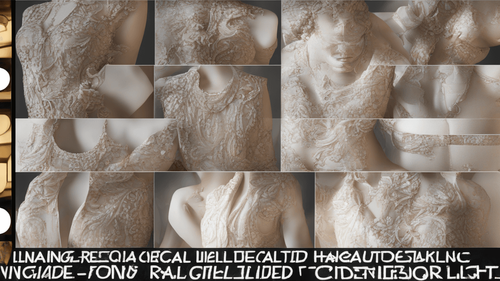
Introduction: The Evolution of Image to Vector AI
In today's rapidly advancing technological landscape, image to vector AI has emerged as a revolutionary solution, bridging the gap between visual creativity and digital precision. This transformative technology has the ability to convert raster images into scalable vector formats, opening up a world of possibilities for industries ranging from graphic design to manufacturing. This article delves deep into the realm of image to vector AI, exploring its applications, benefits, and the incredible impact it is making across various sectors.
Understanding Image to Vector AI
Demystifying Image to Vector Conversion
Image to vector AI, often referred to as vectorization, is a sophisticated process that involves converting pixel-based raster images into vector graphics. Unlike raster images, which are composed of individual pixels and tend to lose quality when resized, vector graphics are defined by mathematical equations and can be resized without any loss of quality. This transformation is achieved through the application of artificial intelligence algorithms, which analyze the color, shape, and patterns within an image to create a vector representation that can be infinitely scaled.
The Inner Workings of Image to Vector Algorithms
Behind the scenes, image to vector AI relies on complex algorithms that leverage machine learning and deep neural networks. These algorithms detect edges, lines, curves, and other geometric features within a raster image, interpreting them as mathematical equations that define the vector version. By breaking down the visual elements into mathematical components, the AI system ensures that the resulting vector graphic retains the essence of the original image while offering unparalleled scalability and precision.
Applications Across Diverse Industries
The versatility of image to vector AI transcends industry boundaries, revolutionizing various sectors:
Graphic Design and Illustration
Image to vector AI is a game-changer for graphic designers and illustrators. It allows them to seamlessly convert hand-drawn sketches or raster images into vector graphics, enabling smoother digital design workflows and providing the flexibility to scale up designs without compromising quality.
Fashion and Apparel
In the fashion world, image to vector AI aids in creating intricate and precise textile patterns. Designers can digitize their concepts, ensuring flawless replication on fabrics and garments. This technology expedites the design-to-production process, reducing time-to-market for new collections.
Engineering and Manufacturing
In the realm of engineering and manufacturing, image to vector AI facilitates the conversion of technical drawings and schematics into accurate vector representations. This not only enhances the precision of designs but also streamlines the production of complex components.
Cartography and Geographic Information Systems (GIS)
GIS professionals can leverage image to vector AI to convert satellite images and maps into vector formats. This simplifies data analysis and map creation, allowing for more detailed and accurate visualizations of geographic information.
Benefits of Embracing Image to Vector AI
Preserving Visual Fidelity
One of the standout advantages of image to vector AI is its ability to maintain visual fidelity even when scaling up or down. This is especially crucial for logos, icons, and illustrations that need to be versatile across different mediums.
Enhancing Editability
Vector graphics generated by AI are inherently editable. Designers can easily modify and manipulate the individual elements of an image without compromising its quality. This flexibility is a boon for creative professionals seeking to refine their concepts.
Enabling Seamless Animations
When it comes to animations and motion graphics, image to vector AI offers a seamless transition. Vector graphics provide smoother lines and curves, resulting in more fluid animations that captivate audiences.
Optimizing Storage and Bandwidth
Vector graphics are inherently lightweight compared to their raster counterparts. This translates to reduced file sizes, making it ideal for web design, where optimizing loading times is crucial for user experience.
Empowering Precision in Manufacturing
In industries like engineering and manufacturing, precision is paramount. Image to vector AI ensures that technical drawings and schematics are accurately represented, minimizing errors and maximizing efficiency in the production process.
FAQs About Image to Vector AI
How Accurate is Image to Vector AI?
Image to vector AI boasts remarkable accuracy, thanks to advanced machine learning algorithms that can identify intricate details and patterns within raster images.
Can Image to Vector AI Convert Complex Artworks?
Absolutely. Image to vector AI excels in converting complex artworks, ensuring that even the most intricate details are preserved in the vector format.
Is Image to Vector AI Suitable for Textile Design?
Yes, image to vector AI is highly suitable for textile design. Designers can digitize their patterns and motifs, guaranteeing precision during the fabric printing process.
Does Image to Vector AI Require Manual Tweaking?
While the AI technology is highly advanced, some projects may benefit from minor manual adjustments to achieve the desired outcome.
What File Formats Does Image to Vector AI Support?
Image to vector AI supports a wide range of file formats, including JPEG, PNG, and GIF, ensuring compatibility with various input sources.
Can Image to Vector AI Be Used for 3D Modeling?
While image to vector AI primarily focuses on 2D images, its output can be incorporated into 3D modeling software for enhanced visualizations.
Conclusion: Embracing the Future of Creativity and Precision
Image to vector AI represents a transformative leap in the world of digital creativity and precision. This technology empowers artists, designers, engineers, and professionals across diverse industries to elevate their work to unprecedented levels of accuracy and scalability. By seamlessly converting raster images into editable vector graphics, image to vector AI is reshaping how we approach design, manufacturing, and data visualization. As this technology continues to evolve, its potential for innovation knows no bounds, promising a future where creativity and precision go hand in hand.